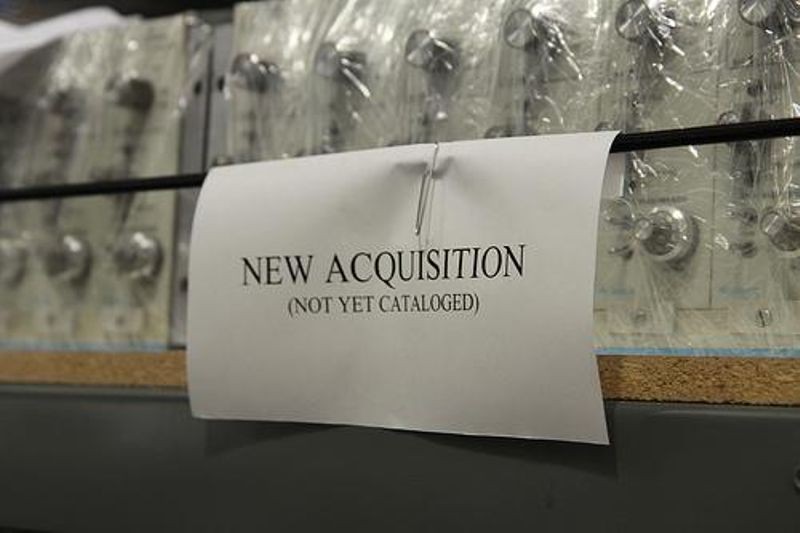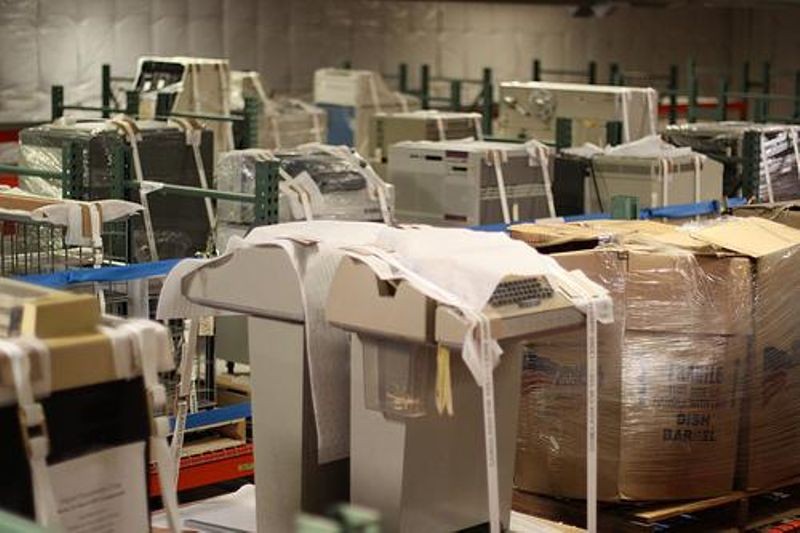
The race is on! The Computer History Museum was recently awarded a prestigious two-year federal grant from the Institute of Museum and Library Services to catalog 10,000 backlogged physical objects (hardware and ephemera). That’s a lot to accomplish in such a short time but we know we’ll cross the Finish Line with our collections volunteers.
If you visited the Museum before the Revolution exhibition opened in 2011, you know that the building underwent some dramatic changes. At 25,000 sq. ft., Revolution was the motivating force behind moving and consolidating most of the artifacts to an offsite storage facility. The exhibit needed to be designed, the artifacts to be selected and the content to be written. Staff time and effort had to be redirected. All the while, CHM was continuing to collect donations large and small knowing the day would come when cataloging with collections volunteers could start again. That day has arrived.
I suspect you’re wondering why the Museum needs volunteers if it received grant funds to execute the project. There are two reasons: expertise and manpower. The project, known as the Collections Cataloging and Reconciliation Project or “CCARP,” requires lots of people—staff and volunteers alike—who are willing to collaborate in teams, to share their knowledge in computer history, technology and museum standards, and to commit to a project that requires accuracy in data entry. Volunteers working in the collections are indispensable for their help in cataloging artifacts for preservation, for display and for public access through the online catalog. Offering volunteer opportunities is one of the best ways for the Museum to engage its stakeholders and their knowledge-base. We have volunteers who network to solicit artifact donations, oral histories and raise money. As part of the Museum’s education programs, others serve as docents in exhibitions or as demonstrators who restore and explain how some systems operate. The Museum simply could not function without the networking and knowledge that hundreds of volunteers have provided over the years.

A sign indicates which shelves contain new materials waiting to be cataloged.
Then there’s manpower. The entire project budget costs just over $452,000 but the IMLS grant covers only 30% of that amount, which is sufficient to hire two part-time temporary collections specialists for a maximum of two years plus some archival supplies. The Museum must support the remaining 70% and the best way to do that is through staff and volunteer time. According to the Independent Sector, volunteer time was valued at $22/hour in 2012. The time volunteers give to CCARP will provide 52% of the Museum’s cost share.
Can 10,000 objects really be cataloged in only two years? Yes! This is actually the second iteration of CCARP funded by IMLS. The first time, from 2007 to 2009, teams cataloged >11,000 objects and uploaded >31,000 images to the collections management database. The end results exceeded the goals: 25% more objects were cataloged and 185% more images were processed than expected. It’s because volunteers invested so much of themselves in CCARP that the Museum realized such success.

IBM retiree and collections volunteer Dave Bennet test drives the new pallet jack, purchased with funding from an IBM Corporate Citizenship grant.
New object records are made public through CHM’s online searchable catalog. Various Museum staff members navigate the catalog to gain the necessary information needed to develop exhibitions, education programs, lectures, and much more. Docents use it to learn more about the collection so they can answer visitors’ questions. Additionally, the metadata for CHM’s online catalog content is made available to Google for web-crawling, so users can find out more about CHM’s artifacts whether they visit our website or use a search engine. As a result, virtual visitors from around the world—not to mention educators, academics, students of all ages, computer enthusiasts, replica builders, authors and others—can access information about the Museum’s holdings. Annually, the Museum receives hundreds of requests for research-level access to artifacts and use of still images from the collection. The online catalog is just one of many ways the Museum delivers its mission to preserve and present the artifacts and stories of the Information Age.
Think you might be interested in becoming a collections volunteer? Helping in collections is fun and easy. CHM’s volunteers are smart, curious and friendly people who typically spend 4-6 hours of their time each week with us. Assisting as a collections volunteer is your opportunity to go behind-the-scenes to work side-by-side with staff curators, registrars and collections specialists and help us identify, describe and photograph literally thousands of artifacts. It’s as if you’re in the race pit, up-close to vintage machines others only dream of seeing.
Plus, it’s a win-win for everyone. You trade us some of your time and knowledge and CHM will return the favor by providing all the training and guidance you’ll need to build skills throughout the process. We start with a collection of small objects that’s partially processed and end with a different collection that requires some research. You’ll advance from training wheels to a Formula 1.

This sampling of artifacts is just a small part of the Museum’s hardware collection.
But you’re wondering if it will be exciting, right? In this blog format, it’s not possible to do justice to all the really cool stuff in CHM’s artifact storage. Most folks expect the facility to resemble an early scene from “Raiders of the Lost Ark,” where Indiana Jones is in a government warehouse packed with crates. It’s way better than that. If you have never had an opportunity before to get an exclusive peek behind the scenes, now is your chance. Why not visit us during one of two Open Houses we’re hosting at our East Bay facility where all the action will take place? Ready to volunteer? Set your sights toward our Volunteer webpage for more information and go!
The Institute of Museum and Library Services is the primary source of federal support for the nation’s 123,000 libraries and 17,500 museums. Its mission is to inspire libraries and museums to advance innovation, lifelong learning, and cultural and civic engagement. Its grant making, policy development, and research help libraries and museums deliver valuable services that make it possible for communities and individuals to thrive. To learn more, visit www.imls.gov.